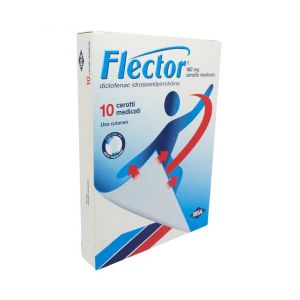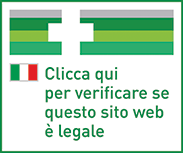Ship in Europe, Find out rates!

Flector dolore e infiammazione 10 cerotti medicati 180mg
BAYER
Local treatment of painful and inflammatory conditions of a rheumatic or traumatic nature of joints, muscles, tendons, ligaments.
1. Therapeutic indications
Flector Patch Medicated is used in the local treatment of painful and inflammatory conditions of a rheumatic or traumatic nature of: joints, muscles, tendons, ligaments.
2. Dosage and method of use
Flector Patch Medicated is used in the following ways: the product must be applied only on intact and healthy skin and must not be applied when taking a bath or shower. The diclofenac medicated plaster should be used for the shortest possible time in relation to the indication for use.
Adults: 1 or 2 patches per day (one application every 12 or 24 hours) for up to 14 days.
Children and adolescents under 16 years: the use of this medicated plaster is not recommended in children and adolescents under the age of 16 years because there are insufficient data to evaluate the safety and efficacy of the medicine.
In adolescents aged 16 years and over, if the product is required for a treatment period exceeding 7 days for pain relief or if symptoms worsen, the patient or the adolescent's relatives are advised to consult their doctor. .
Elderly: this medicine should be used with caution in elderly patients as they are more prone to side effects
3. Contraindications
Hypersensitivity 'to diclofenac or to any of the excipients or to acetylsalicylic acid and other non-steroidal anti-inflammatory drugs.
Patients who have experienced asthma attacks, urticaria or acute rhinitis after taking acetylsalicylic acid or other non-steroidal anti-inflammatory drugs (NSAIDs).
Third trimester of pregnancy and lactation.
Use in children and adolescents under the age of 14 is contraindicated.
4. Pregnancy and breastfeeding
> Pregnancy
The systemic concentration of diclofenac, compared with the oral formulations, is lower after topical administration.
Inhibition of prostaglandin synthesis can negatively affect pregnancy and / or embryo / fetal development. Results of epidemiological studies suggest an increased risk of miscarriage and cardiac malformation and gastroschisis after use of a prostaglandin synthesis inhibitor in early pregnancy.
If diclofenac is used by a woman attempting to conceive, or during the first and second trimester of pregnancy, the dose should be kept as low as possible and the duration of treatment as short as possible. During the third trimester of pregnancy, all prostaglandin synthesis inhibitors can expose the fetus to:
cardiopulmonary toxicity;
renal dysfunction, which can 'progress to renal failure with oligo-hydroamnios;
The mother and the newborn, at the end of pregnancy, may be exposed to:
possible prolongation of bleeding time, and antiplatelet effect;
inhibition of uterine contractions resulting in delayed or prolonged labor.
Consequently, diclofenac is contraindicated during the third trimester of pregnancy.
> Breastfeeding
Diclofenac passes into breast milk in small amounts. However, no effects on the infant are anticipated at therapeutic doses. The product should be used during breastfeeding only under the advice of a healthcare professional. In this circumstance, it should not be applied to the breasts of nursing mothers, nor elsewhere on large areas of skin or for an extended period of time.
5. Expiration and retention
Check the expiration date indicated on the package. The expiry date indicated on the package refers to the product in intact packaging, correctly stored.
Warning: do not use the medicine after the expiry date indicated on the package.
6. Warnings
The possibility of systemic adverse events with the application of topical diclofenac cannot be excluded if the preparation is used on large skin areas and for a prolonged period. Topical diclofenac should only be applied to intact, unaffected skin and not to skin wounds or open lesions. It must not be allowed to come into contact with the eyes or mucous membranes and must not be ingested.
The drug should be used with caution in patients who have had a hypersensitivity reaction to NSAIDs or analgesics in the past. Asthmatic patients, with chronic obstructive diseases of the bronchi, allergic rhinitis or inflammation of the nasal mucosa react with asthma attacks, local inflammation of the skin or mucosa or urticaria with NSAID treatment more often than other patients.
Its use, especially if prolonged, can give rise to sensitization phenomena: interrupt the treatment and establish a suitable therapy. Discontinue treatment if skin rash develops after application. The use of the medicine is not recommended in women who intend to become pregnant. Administration should be discontinued in women who have fertility problems 'or who are undergoing investigation of fertility'. Topical diclofenac can be used with non-occlusive bandages, but should not be used with an occlusive bandage that does not allow air to pass.
7. Composition
Active ingredient: Diclofenac hydroxyethylpyrrolidine 180 mg (equal to 140 mg of Diclofenac sodium)
Excipients: Gelatin, Polyvinylpyrrolidone, Sorbitol 70% solution, Kaolin, Titanium dioxide, Propylene glycol, Methyl parahydroxy benzoate, Propyl parahydroxybenzoate, Disodium edetate, Tartaric acid, Dihydroxyaluminium aminoacetate, Sodium carboxymethylcellulose, Sodium polyacrylate, 1-3 Polysorbate 80, Perfume, Purified water, Synthetic felt, Plastic film.
Flector 10 medicated plasters 180mg
| Destination | Cost | Detail |
|---|---|---|
| Italy | €5,90* | 24/72H |
| Austria, France, Germany, Slovenia | € 13* | 3 days |
| Belgium, Luxembourg, Portugal, Netherlands, Spain | € 14* | 4 days |
| Bulgary, Cechia, Hungary, Poland, Romania, Slovakia | € 19* | 5 days |
| Denmark, Estonia, Finland, Ireland, Lithuania, Latvia ,Sweden | € 22* | 5 days |
| United Kingdom, Switzerland, Greece | € 30* | 7 days |
| Canada, USA | € 40 | 7 Days |
European shipments with express courier: FedEx, MBE, DHL
*For the shipment outside band B ther's an extra cost of 22€ *For the shipment outside band C ther's an extra cost of 30€ Delivery Times exclude Saturday and Holidays
For Islands and Areas of difficult Accessibility the shipments are made in 72 hours and the cost will be increased by 15€
